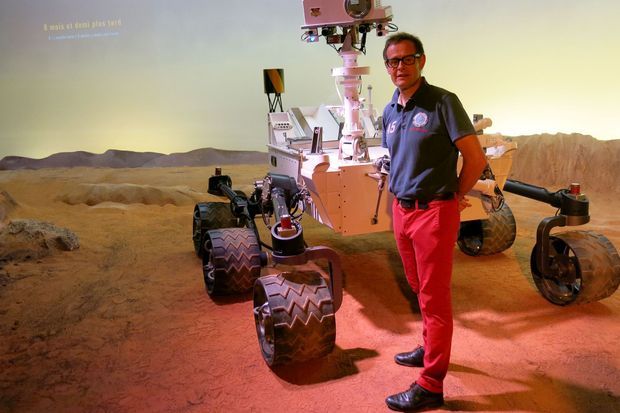The Perseverance robot has been rolling on the planet Mars for exactly one year in search of ancient traces of life. Sylvestre Maurice, astrophysicist at Irap at the University of Toulouse (CNRS/CNES) and co-responsible for the SuperCam instrument, tells us about the year of the rover on the red planet.
What was the first thing you asked Perseverance?
We landed on the red planet and took about three months to check that everything was fine with our vehicle. It’s as if we had tested a car that came out of the factory. We checked that it was turning well on the left, but also on the right, that the battery was working well, etc. Perseverance is the most complicated car in the world, it carries a plutonium reactor, that’s to tell you. We then tested his seven instruments. We are pleased. Everything works wonderfully.
What were the main tasks of the robot during this first year?
The robot collected seven samples of Martian rocks from different locations. We have six years to collect about forty, so we are in the nails. He also rode about four kilometers. This is important, because it allows us to collect rocks located in different places. And then he tested his “MOXIE” device, which makes oxygen from the atmosphere. It will be used one day for astronauts. We continued to operate all of his instruments. His radar was able to see Mars’ subsurface for the first time. Its cameras photographed grandiose Martian landscapes, but also microscopic shots. His microphone recorded the winds. And above all, we put into operation its Franco-American instrument SuperCam.
What is it used for ?
SuperCam has five techniques for observing and analyzing rock mineralogy. It is composed of three spectrometers (LIBS, RAMAN and Infrared), a camera and a microphone. It’s sort of an upgraded version of the ChemCam instrument. The latter equips Curiosity, the NASA vehicle in operation on Mars since 2012. Thus, SuperCam is equipped with a red laser, which heats the rocks to 10,000 degrees, which makes it possible to know the chemical composition of the pebbles. But in addition, the instrument determines the mineralogical composition of the rocks, that is to say the way in which the atoms are organized into molecules and the molecules bound together, thanks to Raman and infrared spectroscopy. These different techniques work at a distance: up to 7 meters for the first, 12 meters for Raman, and up to the horizon for IR spectroscopy and imaging. SuperCam thus performs its analyzes without being forced to get as close as possible to its targets. From France, we have already fired 120,000 laser shots at Mars!
Selfie of Perseverance on Mars. © NASA/JPL-Caltech/MSSS
You encountered failures while collecting rock samples. Is it a perilous exercise?
Yes, we’ve mastered collecting rocks, but it’s really not easy. The first time, we drilled too much and we probably went too fast. The sample fell out before we could seal it. It’s not very serious, because we still have atmosphere in the tube. Another time, there was a small pebble that got in front of the entrance to the sample holder and we couldn’t get the piece of rock inside. This shows us that interplanetary robotics is difficult. We must never forget that Mars is 300 million kilometers from us. You have to be patient and persistent.
To read : “I got it !” Perseverance has harvested the first piece of Martian rock
Head for the delta!
By the way, how is the robot piloted?
It’s very complex. Perseverance executes during the day the programs sent to it the day before. In the evening, it sends its data back to an Orbiter around Mars, which transmits it to one of the three receiving antennas on Earth. In the room of the French Operation Center for Science and Exploration (FOCSE) in Toulouse, there are plenty of screens on which we see the data coming down from Mars. We are connected with the whole world. It takes a hundred people to pilot the rover. We decide what we do in the short and long term. The difficulty is to work together. Everyone wants to do what they want, but everyone’s constraints must be taken into account. But it is exceptional. Every day, we change landscapes. Every day, we discover a territory that no one has ever seen. I don’t compare myself to 15th century explorers, but there is a bit of that. We are where no one has ever driven, it’s amazing.
What was the greatest discovery made?
The camera of Perseverance’s SuperCam instrument detected that it was well within the bottom of an ancient enclosed lake, which was about twice the size of Lake Geneva 3.7 billion years ago. It’s a find that happened very quickly in the adventure. We adjusted a camera, a little by chance, on a hill located in the distance, and this one highlighted strata that we know well on Earth: a delta. But other exceptional discoveries should arrive in the coming months.

Maurice Sylvester. © CNES
Where is the robot heading?
We headed south. We went around a tip of a dune on which we cannot drive. And there, we go at high speed to arrive at the foot of the delta. To give you an idea, we rode about 500 meters last weekend, including 319 meters in a single day, a record! The delta is where the river came gently down in the past. She had carried all the rocks she had on her way and she, in fact, deposited sediments. The goal is to study these sediments. This is the place where we are most likely to find ancient traces of life. We are not likely to find fossils, but traces of microbes or bacteria.
Any reproduction prohibited
